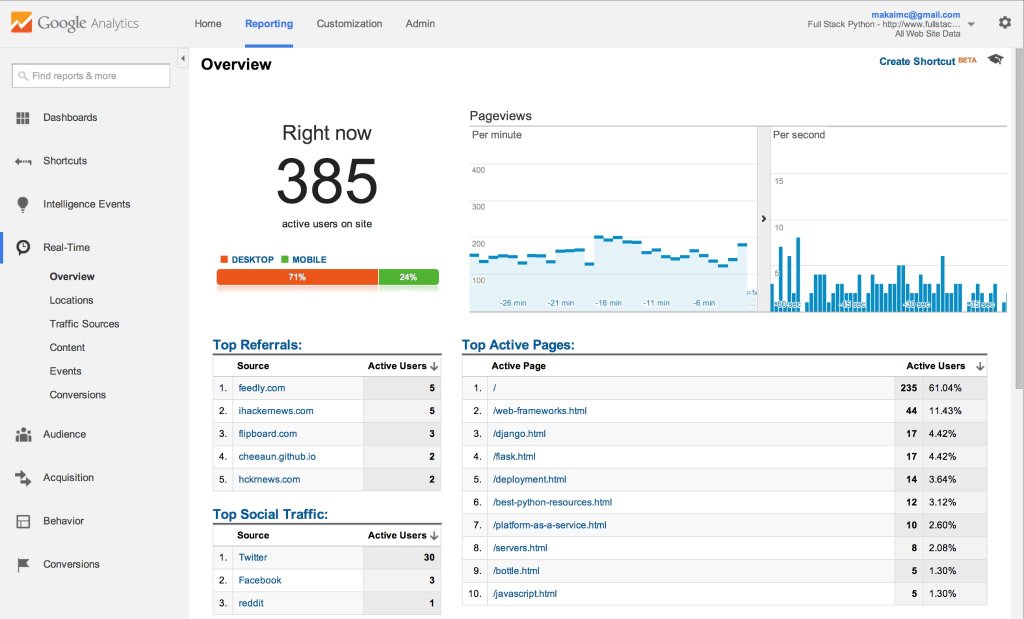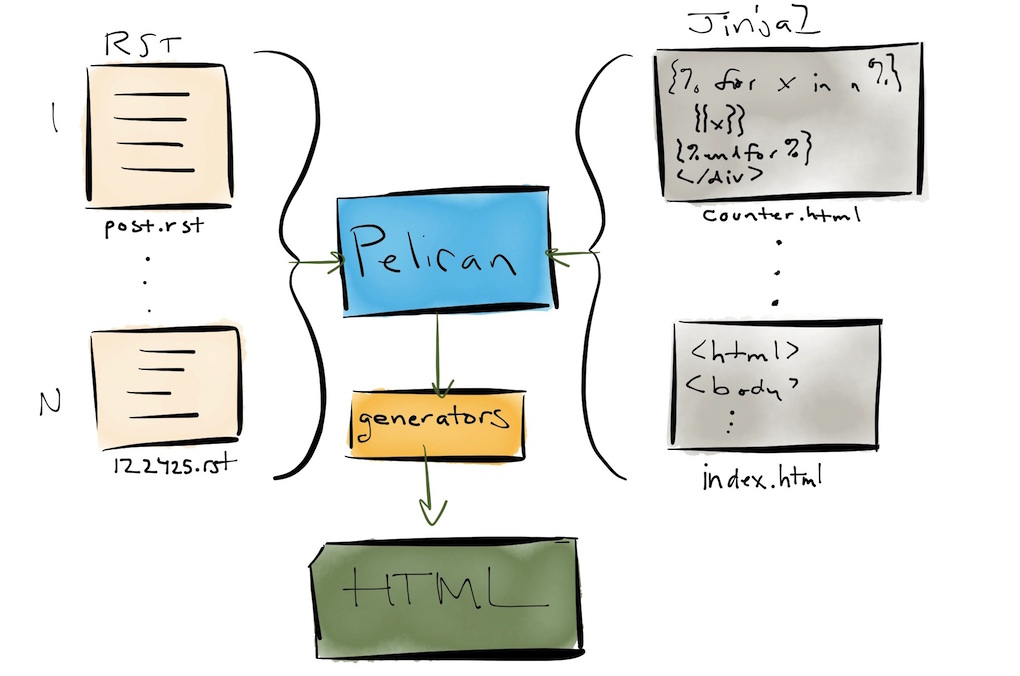Static Site Generator
A static website generator combines a markup language, such as Markdown or reStructuredText, with a templating engine such as Jinja, to produce HTML files. The HTML files can be hosted and served by a web server or content delivery network (CDN) without any additional dependencies such as a WSGI server.
Why are static site generators useful?
Static content files such as HTML, CSS and JavaScript can be served from a content delivery network (CDN) for high scale and low cost. If a statically generated website is hit by high concurrent traffic it will be easily served by the CDN without dropped connections.
For example, when Full Stack Python was on the top of Hacker News for a weekend, GitHub Pages was used as a CDN to serve the site and didn't have any issues even with close to 400 concurrent connections at a time, as shown in the following Google Analytics screenshot captured during that traffic burst.

How do static website generators work?
Static site generators allow a user to create HTML files by writing in a markup language and coding template files. The static site generator then combines the markup language and templates to produce HTML. The output HTML does not need to be maintained by hand because it is regenerated every time the markup or templates are modified.
For example, as shown in the diagram below, the Pelican static site generator can take in reStructuredText files and Jinja2 template files as input then combine them to output a set of static HTML files.

What's the downside of using static site generators?
The major downside is that code cannot be executed after a site is created. You are stuck with the output files so if you're used to building web applications with a traditional web framework you'll have to change your expectations.
Content that is typically powered by a database, such as comments, sessions and user data can only be handled through third party services. For example, if you want to have comments on a static website you'd need to embed Disqus's form and be completely reliant upon their service.
Many web applications simply cannot be built with only a static site generator. However, a static website generator can create part of a site that will be served up by a web server while other pages are handled by the WSGI server. If done right, those web applications have the potential to scale better than if every page is rendered by the WSGI server. The complexity may or may not be worth it for your specific application.
Python implementations
Numerous static website generators exist in many different languages. The ones listed here are primarily coded in Python.
-
Pelican (source code) is a commonly used Python static website generator which is used to create Full Stack Python. The primary templating engine is Jinja and Markdown, reStructuredText and AsciiDoc are supported with the default configuration.
-
MkDocs (source code) uses a YAML configuration file to take Markdown files and an optional theme to output a documentation site. The templating engine is Jinja, but a user doesn't have to create her own templates unless a custom site is desired at which point it might make more sense to use a different static site generator instead.
-
Nikola (source code) takes in reStructuredText, Markdown or Jupyter (IPython) Notebooks and combines the files with Mako or Jinja2 templates to output static sites. It is compatible with both Python 2.7 and 3.3+. Python 2.7 will be dropped in early 2016 while Python 3.3+ will continue to be supported.
-
Acrylamid (source code) uses incremental builds to generate static sites faster than recreating every page after each change is made to the input files.
-
Hyde (source code) started out as a Python rewrite of the popular Ruby-based Jekyll static site generator. Today the project has moved past those "clone Jekyll" origins. Hyde supports Jinja as well as other templating languages and places more emphasis on metadata within the markup files to instruct the generator how to produce the output files. Check out the Hyde-powered websites page to see live examples created with Hyde.
-
Grow SDK (source code) uses projects, known as pods, which contain a specific file and directory structure so the site can be generated. The project remains in the "experimental" phase.
-
Lektor (source code) is a Python static content management system that can deploy to any webserver. It uses Jinja2 as a template engine.
-
Complexity (source code) is a site generator for users who like to work in HTML. It uses HTML for templating but has some functionality from Jinja for inheritance. Works with Python 2.6+, 3.3+ and PyPy.
-
Cactus (source code) uses the Django templating engine that was originally built with front-end designers in mind. It works with both Python 2.x and 3.x.
Open source Python static site generator examples
-
This site is all open source in its own GitHub repository under the MIT license. Fork away!
-
Django REST Framework uses MkDocs to create its documentation site. Be sure to take a look at the mkdocs.yml file to see how large, well-written docs are structured for that project.
-
Practicing web development uses Acrylamid to create its site. The code is open source on GitHub.
-
Linux Open Admin Days (Loadsys) has their site open source and available for viewing.
-
The Pythonic Perambulations blog has a fairly standard theme but is also open source on GitHub.
Static site generator resources
-
The Long Road to Building a Static Blog with Pelican is a fantastic read that really gets into the details throughout the walkthrough.
-
Staticgen lists static website generators of all programming languages sorted by various attributes such as the number of GitHub stars, forks and issues.
-
Static site hosting with S3 and Cloudflare shows how to set up an S3 bucket with Cloudflare in front as a CDN that serves the content with HTTPS. You should be able to accomplish roughly the same situation with Amazon Cloudfront, but as a Cloudflare user I like their service for these static site configurations.
-
Getting Started with Pelican and GitHub Pages is a tutorial I wrote for getting up and running with Full Stack Python's source code, which uses Pelican to generate the site.
-
The title is a big grandiose, but there's some solid detail in this article on why static website generators are the next big thing. I'd argue static website generators have been big for a long time now.
-
Static site generators can be used for a range of websites from side projects up to big sites. This blog post by WeWork on why they use a static site generator explains it from the perspective of a large business.
-
Getting started with Pelican and GitHub pages is a tutorial I wrote to use the Full Stack Python source code to create and deploy your first static site.
-
Ditching Wordpress and becoming one of the cool kids is one developer's experience moving away from Wordpress and onto Pelican with reStructuredText for his personal blog.
What else do you want to learn about Python web dev?

Searching for a complete, step-by-step deployment walkthrough? Learn more about The Full Stack Python Guide to Deployments book.
Email Updates
Static Site Generators
Need more detailed tutorials than you see here? Learn more about The Full Stack Python Guide to Deployments book.

